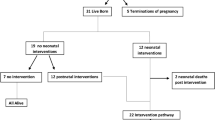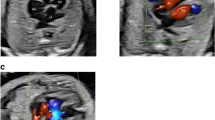Abstract
Congenitally corrected transposition of the great arteries (ccTGA) is a rare cardiac defect characterized by the atria connecting with anatomically discordant ventricles and the ventricles connecting with discordant and transposed great arteries, which allows hemodynamic compensation. Most patients with ccTGA have associated intracardiac anomalies, which could be a diagnostic clue, whereas isolated forms are infrequently diagnosed during the neonatal period and in utero. We describe a fetus that was diagnosed with ccTGA and without additional cardiac anomalies at 25 weeks of gestation. The parallel course of the great arteries discovered during a routine obstetric scan indicated this rare cardiac anomaly. Further detailed examination of the ventricular morphology helped to confirm the diagnosis. Despite hemodynamic compensation, the long-term prognosis of ccTGA is uncertain because of the possible development of arrhythmias or heart failure later in life. Our findings showed that fetal echocardiography can detect prenatal ccTGA.


Similar content being viewed by others
References
Santoro G, Masiello P, Baldi C, Farina R, Fittipaldi O, Di Benedetto G (1997) Corrected transposition of the great arteries with isolated aortic coarctation: in utero echocardiographic diagnosis. Pediatr Cardiol 18:396–398
Rutledge JM, Nihill MR, Fraser CD, Smith OE, McMahon CJ, Bezold LI (2002) Outcome of 121 patients with congenitally corrected transposition of the great arteries. Pediatr Cardiol 23:137–145
McEwing RL, Chaoui R (2004) Congenitally corrected transposition of the great arteries: clues for prenatal diagnosis. Ultrasound Obstet Gynecol 23:68–72
Kawabata K, Watanabe K, Chiba Y (2005) Prenatal diagnosis of congenitally corrected transposition of the great arteries. Fetal Diagn Ther 20:16–19
Allan LD, Chita SK, Sharland GK, Fagg NLK, Anderson RH, Crawford DC (1989) The accuracy of fetal echocardiography in the diagnosis of congenital heart disease. Int J Cardiol 25:279–288
Freedom RM, Dyck JD (1995) Congenitally corrected transposition of the great arteries. In: Emmanouilides GC, Riemenschneider TA, Allan HD, Gutgesell HP (eds) Moss and Adams heart disease in infants, children, and adolescents including the fetus and young adult, 5th edn. Wiliams & Wilkins, Baltimore, pp 1225–1242
Presbitero P, Somerville J, Rabajoli F, Stone S, Conte MR (1995) Corrected transposition of the great arteries without associated defects in adult patients: clinical profile and follow up. Br Heart J 74:57–59
Conflict of interest statement
None of the authors have any conflicts of interest in connection with this work.
Author information
Authors and Affiliations
Corresponding author
Rights and permissions
About this article
Cite this article
Shima, Y., Nakajima, M., Kumasaka, S. et al. Prenatal diagnosis of isolated congenitally corrected transposition of the great arteries. Arch Gynecol Obstet 279, 557–559 (2009). https://doi.org/10.1007/s00404-008-0739-8
Received:
Accepted:
Published:
Issue Date:
DOI: https://doi.org/10.1007/s00404-008-0739-8




